| Pages:
1
2
3
4
..
6 |
Laboratory of Liptakov
International Hazard
    
Posts: 1335
Registered: 2-9-2014
Location: Technion Haifa
Member Is Online
Mood: cool.gif
|
|
NPED
I use a translator. Maybe I do not understand the answers from Ral123. If it is easy to add monohydrazinenitrate? Let's do it. In the patent, the
catalyst / modifier: beta resorcin lead and lead salicylate. 2 + 2%. And black lamp 0.2%. Based on the content of nitrocellulose. NC12,6N is a binder
for the agglomerates from 0.1 to 0.5 millimeters. NC content is 5%. MHN is stable? At least to 80C for several hours? If so, try it. Or try to use
only black lamp. About 0.4% from NC. Here are suggestions on how to simplify the design. Fig. 1,2,3,4. LL
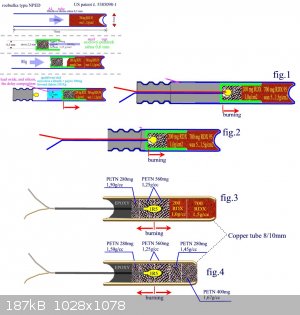
|
|
|
roXefeller
Hazard to Others
  
Posts: 463
Registered: 9-9-2013
Location: 13 Colonies
Member Is Offline
Mood: 220 221 whatever it takes
|
|
Or was it mannitol hexanitrate?
|
|
|
NeonPulse
Hazard to Others
  
Posts: 417
Registered: 29-6-2013
Location: The other end of the internet.
Member Is Offline
Mood: Isolated from Reality! For Real this time....
|
|
Mannitol Hexanitrate. And Ral123 is right. Stability of this compound is not too great, perhaps slightly better with a betaine stabilizer. You would
have to make them and use them to order. As a stability test for my references I made two sets of MHN dets. Two of them kept in an old hot car in the
yard for a 3 weeks, and two were made for immediate use. The cars temp during the day would have been 30-40℃ and upon testing them the warm stored
ones showed a definite loss of power over the fresh units.
|
|
|
Ral123
National Hazard
   
Posts: 735
Registered: 31-12-2011
Member Is Offline
Mood: No Mood
|
|
If the MHN has decomposed to the point it has lost power, that's telling how dangerous it is, I thought it was more stable. How was it purified?
|
|
|
Laboratory of Liptakov
International Hazard
    
Posts: 1335
Registered: 2-9-2014
Location: Technion Haifa
Member Is Online
Mood: cool.gif
|
|
NPED
Who of us amateurs will leave detonators in a hot car three weeks? It will not do even with original detonators. As a stability test = excellent.
Mannitol hexanitrate can try. But it is necessary to perform many tests. Other pressing pressures. I advocate keeping with PETN. Should the test PETN.
Together with catalysts. Lamp black or ammonium perchlorate. Or other available accelerators.
LL
|
|
|
Laboratory of Liptakov
International Hazard
    
Posts: 1335
Registered: 2-9-2014
Location: Technion Haifa
Member Is Online
Mood: cool.gif
|
|
NPED
The picture is what to do with PETN. The catalyst need not be present there. System NPED works without catalysts. The cavity 8 mm system should work.
The catalysts are added for reliable function at - 30C. Do not use acetone. Use EtOAc-. Densities what are the figures must be tested. Number of press
operations as well. I recommend to start Fig.4.
LL
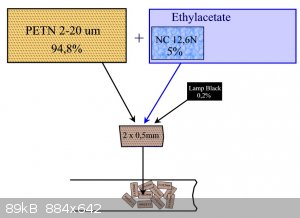
|
|
|
Laboratory of Liptakov
International Hazard
    
Posts: 1335
Registered: 2-9-2014
Location: Technion Haifa
Member Is Online
Mood: cool.gif
|
|
NPED
Another way to make a strong NPED detonator is this. Who has PETN, may try to make. It should work. LL
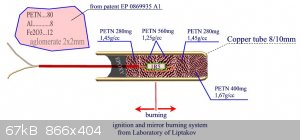
|
|
|
specialactivitieSK
Hazard to Self
 
Posts: 94
Registered: 21-10-2014
Member Is Offline
Mood: No Mood
|
|
Nitro Nobel experimented with zener diodes ( reverse polarity ). Ignition of smokeless powder.
For example, different diodes :
http://www.youtube.com/watch?v=ywdtKZb_JIQ
http://www.youtube.com/watch?v=CUTUa8Ngt-M
[Edited on 21-11-2014 by specialactivitieSK]
|
|
|
Laboratory of Liptakov
International Hazard
    
Posts: 1335
Registered: 2-9-2014
Location: Technion Haifa
Member Is Online
Mood: cool.gif
|
|
kick
If the electronic component (capacitor, diode, transistor, etc.) managed to kick the PETN detonation velocity, it would be interesting. As I know, the
only thing that works is exploding wire. That's no way for amateur research. LL
|
|
|
Bert
Super Administrator
        
Posts: 2821
Registered: 12-3-2004
Member Is Offline
Mood: " I think we are all going to die. I think that love is an illusion. We are flawed, my darling".
|
|
Managing to assemble a big enough capacitor bank, no problem.
High voltage power supply, a little challenge, a bit of danger.
Making a fast enough switching circuit that won't self destruct and configuring the whole firing system including the OUTPUT LINE so that current rise
across the exploding element is steep enough... Big challenge for a non engineer. And since you will likely be losing at least part of your output
line on many uses?
Rapopart’s Rules for critical commentary:
1. Attempt to re-express your target’s position so clearly, vividly and fairly that your target says: “Thanks, I wish I’d thought of putting it
that way.”
2. List any points of agreement (especially if they are not matters of general or widespread agreement).
3. Mention anything you have learned from your target.
4. Only then are you permitted to say so much as a word of rebuttal or criticism.
Anatol Rapoport was a Russian-born American mathematical psychologist (1911-2007).
|
|
|
Laboratory of Liptakov
International Hazard
    
Posts: 1335
Registered: 2-9-2014
Location: Technion Haifa
Member Is Online
Mood: cool.gif
|
|
BERTA system
Pyro amateurs around the world still use HMTD, TATP and other dangerous substances. Here I present, makes available invention Ecological shock tubes
on the based TeACP. Stability DDT is limited to 90 days at ambient temperature 15C. Confirmed.
Ecological initiator is safe for production. Made over 1000 without incident, without exploding. This is the main reason for the publication. The
development lasted more than two years. The device is called Berta system. This is the Czech acronym commercial designation. English is: lead-free
ecological impact tube on the tetraammin based. Here you have the opportunity to study ecological initiator system Berta. The design is very simple
and easy. But for the production of the required precision press and precision stamping tools. Experienced researchers and professionals are able to
construct a system Berta. This requires knowledge of mechanics. Accurate and detailed description of tools and products for production will not be
published. Technological process will not be published. This is to protect against hot heads. For filling the shock tube, it is necessary to produce a
specific grain size and composition. And follows: 1) TeACP fraction is basic to 0,05 to 0,2 mm, wet 1-3%. 2) In 5g NH3 25% aq, dissolved 1.4 g
NH4ClO4. 3) This was mixed with 8.4 g TeACP fraction. Arises dough. 4) The dough is dried to form wet lumps having a water content of about 10-20%. 6)
Wet lumps through a sieve 2x2m. This produces granules. 8) The granules are dried to a moisture content of 1-5% H2O/NH3 free. 9) Use 1x1m sieve is
collected, separated fine particles smaller than 1x1m. We therefore granule 1x1 to 2x2m. Like for gunpowder. These grains are then compressed
according to the diagram. First, 3700 kg / cm2. The area is 0.502 cm2. This means the pressing pressure 1850 kg /cm2. Tolerance pressure is 10%.
Weight is 0.5 grams for a segment. A total of 3 g + - 10% as well. Then 1000 kg and so on, by diagram. Both ends are provided with PIB. Protection
against loss of H20 and NH3 from molecule TeACP. In this way stability is achieved for 90 days. For reliable transition DDT. Rezistor is clasic
metalic 1R5/0,6W. BasicVoltage is 6V/1A, delay 1s. Or 12V/ xA from acumulator, delay about 0,05s (instant). Berta no contains bulkheads and other
excipients.Only 86 TeACP, 14 NH4ClO4 + H2O/ NH3 free. This is key for reliability DDT. Confirmed. Production TeACP is very easy. No carcinogenic
metals. Ni, Co, Pb, Hg and others.For production, it should only NH4ClO4, Cu wire and ammonia water 24-25% technical quality. Detonation pressure
detonator Berta is 25 GPa. RDX has 28 GPa. Deminers around the world looking for a safe initiator without primary substances, without the heavy
metals. Here it is. This is a ecological Berta high explosive system. Use as a pellet Tetryl, for example 4,5g 15x15mm pellets. ingredients: TeACP
fine dust 93% + 3% H2O / NH3 free, 2% PIB and 2% oil 5W40. Pressing to a density of 1.75 -1.85 g / cm3. VoD 7000-7500 m /s. Like is Berta detonator
output segment.
This system is able to launch any secondary explosive. Albert Einstein once said. Things should be done as simply as possible. But not simpler. This
system is Berta. Simply. For research purposes and tests. Cu tube is 50x8/10mm.
... ...LL ...LL
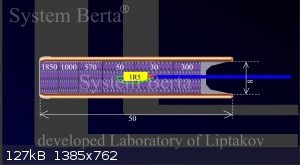
|
|
|
Rosco Bodine
Banned
Posts: 6370
Registered: 29-9-2004
Member Is Offline
Mood: analytical
|
|
tetraamine copper perchlorate
@LL I thought I had posted this before long ago.
You may find this information on TACP interesting
http://parazite.nn.fi/roguesci/index.php/t-158-p-7.html
file attached for posterity
Attachment: TACC, TACN, and tetramine copper perchlorate [Archive] - Page 7 - The Explos.pdf (37kB)
This file has been downloaded 3539 times
|
|
|
Laboratory of Liptakov
International Hazard
    
Posts: 1335
Registered: 2-9-2014
Location: Technion Haifa
Member Is Online
Mood: cool.gif
|
|
Berta system
Yes, I read these articles before about 1 year. It's a good article, description TACP. Berta system is the next step. A comprehensive system that
works reliably. For Berta initiator is important to 1-5% moisture prior to pressing. Production of shock tubes Berta here: https://www.youtube.com/watch?v=JFxbdp-I0hw
Easy prepare TACP here: https://www.youtube.com/watch?v=CEdMVq1uM4I
...LL...
|
|
|
Rosco Bodine
Banned
Posts: 6370
Registered: 29-9-2004
Member Is Offline
Mood: analytical
|
|
TACP has a positive oxygen balance which enables use of a fuel or use of an energetic fuel in mixture with TACP to achieve oxygen balance. The oxygen
balanced mixture is also more sensitive to initiation. I tried this using paraffin as 2.75 parts plus 97.25 parts TACP for a good mixture.
I did not test a mixture 85:15 of TACP with NH4ClO4 which would have even greater positive oxygen balance. I do not know why you would use 15%
of NH4ClO4 or what is the advantage for such a mixture compared with 100% TACP.
Why do you use 15% NH4ClO4?
|
|
|
Laboratory of Liptakov
International Hazard
    
Posts: 1335
Registered: 2-9-2014
Location: Technion Haifa
Member Is Online
Mood: cool.gif
|
|
Berta system
Who would have thought that an emulsion containing 12% water and ammonium nitrate will be the explosive?
Or Guglielmo Marconi. Antenna across the ocean does not work upwards? Put it in reverse. Was performed (Berta) over 1000 trials. Every little
differently. The oxygen balance in Berta is + 17.42. I know it sounds like nonsense. Similarly, as the above examples. Without AP Berta also works.
Very poorly, or not at all. Unfortunately, I can not explain it. Containing 12-15% of the AP is working at 100%... ...LL ...LL
There are things between heaven and earth.
[Edited on 18-2-2015 by Laboratory of Liptakov]
|
|
|
Rosco Bodine
Banned
Posts: 6370
Registered: 29-9-2004
Member Is Offline
Mood: analytical
|
|
Perhaps the detonation of AP is catalyzed by the Cu ion from the TACP.
Have you tried paraffin as a sensitizer and graining additive for the 85:15 mixture?
You describe a good 90 day storage for the 85:15 mixture. There appeared to be no storage issue for the sample of unmixed TACP which I tested. The
sample was kept for a couple of years and it showed no apparent change.
|
|
|
Laboratory of Liptakov
International Hazard
    
Posts: 1335
Registered: 2-9-2014
Location: Technion Haifa
Member Is Online
Mood: cool.gif
|
|
The addition of paraffin to 85:15 Not tested, no paraffin. Dry TACP (about 0,3% H2O) loses the ability to DDT. After 3 days. And it certainly. In the
tube not work a like detonator. Loss of DDT. Confirmed at least 100x. 3-5 days old dry TACP@1,85 with primer LA 200mg, full detonation, speed of 7500
m/s. 10 -20 days old dry TACP@1,85 init. LA, only deflagration. Total loss of DDT, in Cu tube 8/10 of course. It is my experience... ...LL ...LL
|
|
|
Rosco Bodine
Banned
Posts: 6370
Registered: 29-9-2004
Member Is Offline
Mood: analytical
|
|
For 1.5 grams TACP with no paraffin a 1/4" column diameter loaded at 8,000 psi, 300mg LA produced complete detonation.
For 1.5 grams TACP with paraffin 2.75% a 1/4" column diameter loaded at 8,000 psi, 200mg LA was reduced amount produced complete detonation.
The same test condition for TACP from the same batch with paraffin increased to 6.75% produced only partial detonation.
All tests unreenforced caps fired by fuse not crimped
There were not repeated tests done on material after long storage. But there was no apparent change in the stored samples, no odor of ammonia on
opening containers, no color change. The material dried at 95C appeared storage stable to me. I also left a sample out openly exposed to air for
extended time and it appeared stable also.
|
|
|
Laboratory of Liptakov
International Hazard
    
Posts: 1335
Registered: 2-9-2014
Location: Technion Haifa
Member Is Online
Mood: cool.gif
|
|
Berta also works in other specific forms. For example TACP + HMTA 100: 7. Even in the cavity 6 mm. Or with clean TACP. But the stability of the
transition DDT is not verified. (3 mon.) It's still research... ...LL ...LL
|
|
|
Hennig Brand
International Hazard
    
Posts: 1284
Registered: 7-6-2009
Member Is Offline
Mood: No Mood
|
|
Thermal Shock Initiation Using Molten Metal
Was doing some soldering today and out of curiosity I dropped little blobs of molten 60-40 solder on very small quantities of ETN sitting on a piece
of scrap wood which caused the ETN to flash and snap loudly. I think this effect could be harnessed and used for a NPED design.
Lead and some of its alloys have very good thermal conductivity, significant ability to store energy as latent and sensible heats especially if
considered in terms of volume, flow well when molten and have a melting point above that which is needed to thermally shock ETN, MHN, NG and others.
Haven't quite got all the specifics worked out, but I think this could work well. I does rely on gravity, however, since molten metal falls towards
the center of the earth which will govern the orientation of at least that part of the cap. Even 60-40, tin-lead, solder has a melting point over 180C
and with a little ingenuity it can be heated well above its melting point before being dumped on the secondary explosive below thermally shocking it
into detonation. My initial thought was that the heating element (electrical resistive element) could be positioned high in the lead alloy and the
bottom could have a layer of higher melting alloy to ensure that the main bulk of the lower melting alloy above was well above its solidification
point before the bottom layer melted dumping the molten heat sink. The molten lead would provide confinement as well, during the initial moments of
contact, which would increase the effect. Obviously the heating element will have to be electrically insulated from the conductive lead alloy
(something which I am still thinking about). I suppose a hot burning pyrotechnic mixture placed over the solid lead such as a thermite type mixture
could be used in place of the electrical heat element (not sure if this is practical).
Here are some thermal properties of 60-40 solder taken from the following website:
http://www.matweb.com/search/datasheet.aspx?matguid=06a31d97...
Heat of Fusion: 37.0 J/g
Specific Heat Capacity: 0.173 J/g.C
Thermal Conductivity: 49.8 W/m.K
Melting Point: 183-190C
Solidus: 183C
Liquidus: 190C
Also the viscosity is given as 2cP at 190C, which is only double that of room temperature water, and so will flow through holes and into tight
crevices making excellent contact with the explosive to be initiated very quickly.
Attachment: Alloy Temperature Chart (Kester).pdf (74kB)
This file has been downloaded 1274 times
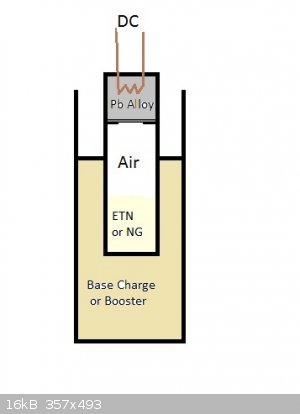
The thermal conductivities of the common lead free solders are even higher at about 60 W/m.K, as well as having higher melting temperatures and
greater heat capacities owing to the much higher tin content and no lead.
edit:
I suppose a bit of glass or maybe ceramic tubing, or some other electrical insulator, could be used to hold the alloy to be melted and it could be
heated through the tubing sidewall by nichrome wire or other resistive element wrapped around the tubing. Still thinking.
[Edited on 7-4-2015 by Hennig Brand]
"A risk-free world is a very dull world, one from which we are apt to learn little of consequence." -Geerat Vermeij
|
|
|
Laboratory of Liptakov
International Hazard
    
Posts: 1335
Registered: 2-9-2014
Location: Technion Haifa
Member Is Online
Mood: cool.gif
|
|
This is very interesting. Dripping lead (solder) on ETN. But the condition of gravity, it is a big limitation. I see a similarity. ETN heated and
molten on the aluminum thin plate (foil) exploded. Reliably. But the practical use (as detonator) is very difficult...LL
|
|
|
PHILOU Zrealone
International Hazard
    
Posts: 2893
Registered: 20-5-2002
Location: Brussel
Member Is Offline
Mood: Bis-diazo-dinitro-hydroquinonic
|
|
Other ideas:
Fe powder + S (flower) --> FeS (like a cigarette burning)
Al2+ 3S --> Al2S3 (with exces Al for ETN ignition)
FeO or Fe2O3 thermite
PbO or PbO2 thermite
Cu2O or CuO thermite
PH Z (PHILOU Zrealone)
"Physic is all what never works; Chemistry is all what stinks and explodes!"-"Life that deadly disease, sexually transmitted."(W.Allen)
|
|
|
Hennig Brand
International Hazard
    
Posts: 1284
Registered: 7-6-2009
Member Is Offline
Mood: No Mood
|
|
Quote: Originally posted by Laboratory of Liptakov  | | This is very interesting. Dripping lead (solder) on ETN. But the condition of gravity, it is a big limitation. I see a similarity. ETN heated and
molten on the aluminum thin plate (foil) exploded. Reliably. But the practical use (as detonator) is very difficult...LL |
I think the molten metal, at a temperature above the decomposition temperature of the explosive, could easily provide a great deal more near
instantaneous thermal shock, which I think would result in more reliability. I haven't tested it, but it seems logical. I am thinking of the
experiments where NG is dropped on hot steel and made to detonate.
"A risk-free world is a very dull world, one from which we are apt to learn little of consequence." -Geerat Vermeij
|
|
|
MineMan
National Hazard
   
Posts: 998
Registered: 29-3-2015
Member Is Offline
Mood: No Mood
|
|
Thermite
I agree with the others, you could use an electric current in a high resistant wire to heat up lead and drip it onto ETN, or you could make molten
iron from thermite instantly. I would be curious if anyone had had any success on this?
|
|
|
Hennig Brand
International Hazard
    
Posts: 1284
Registered: 7-6-2009
Member Is Offline
Mood: No Mood
|
|
There may be a certain temperature, or range of temperatures, that works best to initiate the ETN or MHN, etc (like NG being dripped on hot steel
where the right temperature causes immediate detonation). By choosing the correct alloy with the correct melting point it should be possible to set
the temperature reasonably accurately. Thermal shock to me indicates very rapid transfer of energy to increase the temperature of the explosive
extremely quickly to above its decomposition point and I think dropping a highly conductive molten metal of low viscosity on the sample does it well.
I suppose a thermite type reaction could work as well, but I don't think lighting a combustible mixture in contact with the explosive will provide
nearly the same thermal shock (steep power curve) or be as controllable with regards to temperature or rate of heat transfer. Maybe it won't work at
all, but it seems promising to me except for the gravity issue.
"A risk-free world is a very dull world, one from which we are apt to learn little of consequence." -Geerat Vermeij
|
|
|
| Pages:
1
2
3
4
..
6 |